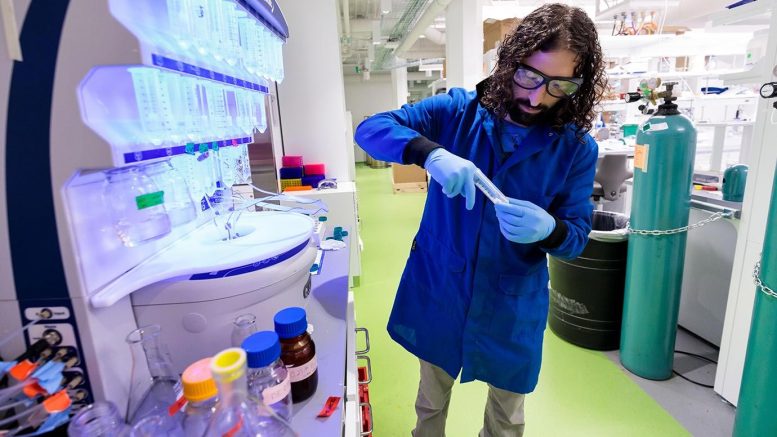
Graduate student Uri Zvi works in the Esser-Kahn lab at the Pritzker School of Molecular Engineering at the University of Chicago. The lab is one of several that have rapidly pivoted to research on a COVID-19 vaccine. Credit: John Zich
As scientists around the world rush to learn more about COVID-19, several labs at the University of Chicago’s Pritzker School of Molecular Engineering are taking an innovative approach to vaccine development.
While some companies are already beginning to test vaccine formulations in small trials, there are a lot of potential hurdles to the finish line. It’s important to be exploring approaches from multiple angles, scientists say.
“The reality of vaccine work is that a lot of them won’t turn out, so it’s better to have a deep bench,” said Aaron Esser-Kahn, an associate professor of molecular engineering whose lab has rapidly shifted to address the coronavirus pandemic.
His lab is one of several at PME that is taking a slightly different tack in exploring vaccine development than most commercial labs. Melody Swartz, the William B. Ogden Professor of Molecular Engineering, and Jeff Hubbell, the Eugene Bell Professor in Tissue Engineering, are two others.
‘Turbocharging’ vaccine performance
Esser-Kahn researches the immune system and vaccines, but he previously worked on other diseases including influenza. Because the flu virus mutates so fast, one of their approaches has been to find molecules that boost any vaccine they are added to. COVID-19 doesn’t mutate as fast as the flu, but the same approach is useful, as scientists are exploring many different vaccine avenues for a vaccine in parallel—and these could be added to any promising candidate.
“The idea is that you can add these molecules to many vaccines, and it will improve the response you get,” said Esser-Kahn.
There are two parts to virtually all vaccines. One part is some version of the virus in question, usually with some essential parts lopped off to make it tamer, so that the immune system can learn to recognize it. Then there’s an ‘adjuvant,’ which is the wake-up call for the immune system.
One of Esser-Kahn’s approaches is to adjust the adjuvant to activate immune cell called CD4+ cells. These cells protect the lungs in flu, SARS and Zika infections; and since COVID-19 tends to attack the lungs, it’s possible that marshalling a strong CD4+ response could offer better protection. “We tried this recently with smallpox, and saw good response,” Esser-Kahn said.
“Another angle is to add a third component to the vaccine, made up of molecules that control how the body responds to the vaccine. These would tweak cells’ signaling processes to help the body better respond to COVID-19 with less chance of side effects.”
Finally, Esser-Kahn is also interested in an approach called “trained immunity.” “This one’s in a very early stage, but we think it has a lot of potential,” he said.
It’s been observed that getting vaccines sometimes reduces a person’s overall likelihood of getting sick—even with diseases that the vaccine wasn’t treating directly. For example, people who get vaccinated for tuberculosis are less likely to get the flu that winter.
“We think this is because the immune system is on extra alert,” Esser-Kahn said. They’ve zeroed in a particular molecule called beta-glucan, which is a nontoxic sugar molecule. “We wondered, if we just inject beta-glucan without the rest of the vaccine, it could boost the overall immune response against any pathogen,” he said.
Instead of a true vaccine, this would instead boost a person’s initial immune response if they were infected, buying time while the immune system makes specific antibodies to COVID19. A slow-release formulation would allow the system to mount a measured response over many days.
If it works, it could be used for any pandemic, Esser-Kahn said—given as a preventative to people who are most at risk, such as healthcare workers. But because it’s a new idea, they have to do fairly extensive testing first.
A novel delivery system
Another approach is to work on the delivery system of the vaccine. Swartz and Hubbell, both molecular engineers, have previously developed nanoparticle vaccines.
Nanoparticles are easy to make, and they form naturally into little capsules that can be easily customized with any of the viral proteins identified as good for vaccines. “We know from previous work that you can get better responses if you incorporate the viral protein and the adjuvant within the nanoparticles,” Swartz said.
For example, researchers can attach molecules that serve as a kind of “mailing address” to get the vaccine to the specific areas or kinds of cells they want to activate, which can enhance the effectiveness of the vaccine. “How you target the nanoparticle to the right cell populations, and how you induce the cells to then uptake them and become activated, is critical,” Swartz said.
In this case, they want to target lymph nodes, the organs in the body that are one of the frontlines for the immune system. Within the node, there are specific cells that trigger different types of responses; Swartz and Hubbell want to induce production of a particular kind of antibody called “broadly neutralizing antibodies.” These are antibodies that seem to act on a variety of virus strains, and thus may be able to clear several strains of the virus.
“We’ll start by making various variants of the vaccine and testing them in mice to see which drives the best response, in terms of the breadth and potentency of virus-specific antibodies,” Swartz said. They’re also developing a way to test small amounts of human immune cells in microdevices on the benchtop, to complement the results from mice.
They have previously seen good success with the approach in malaria vaccines as well as tuberculosis and Lassa fever, so they hope to adapt it quickly to COVID-19.
“We’ve just started testing in mice,” Swartz said. “If all goes well, we could be ready for advanced animal studies in the early fall.”


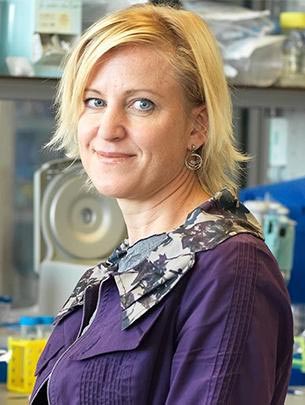
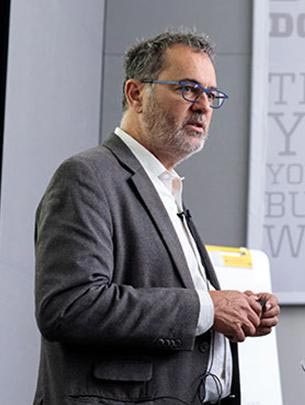


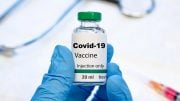
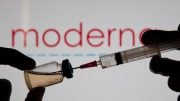

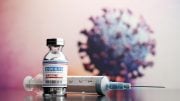
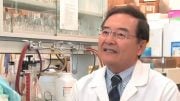
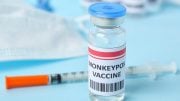
Be the first to comment on "Innovative Approaches to COVID-19 Vaccine Taken by Molecular Engineers"